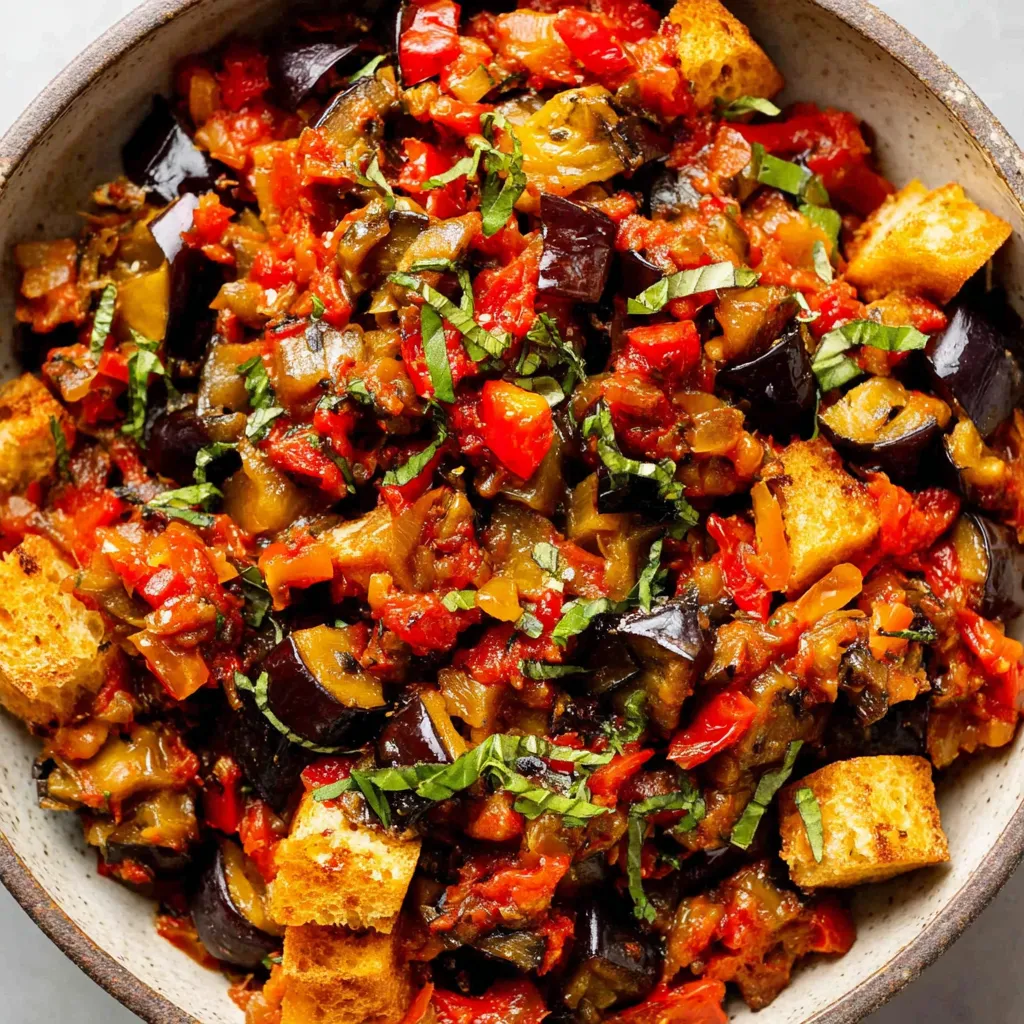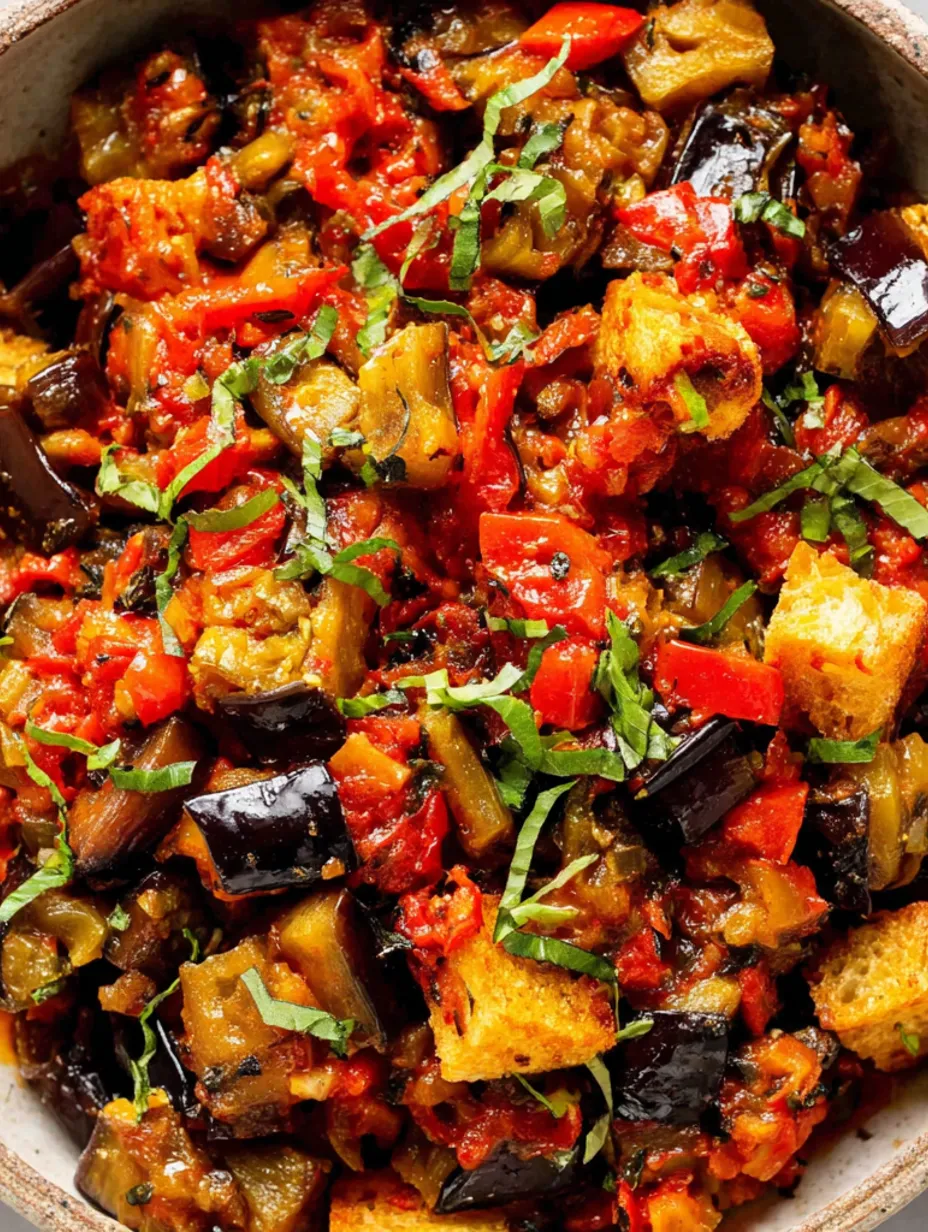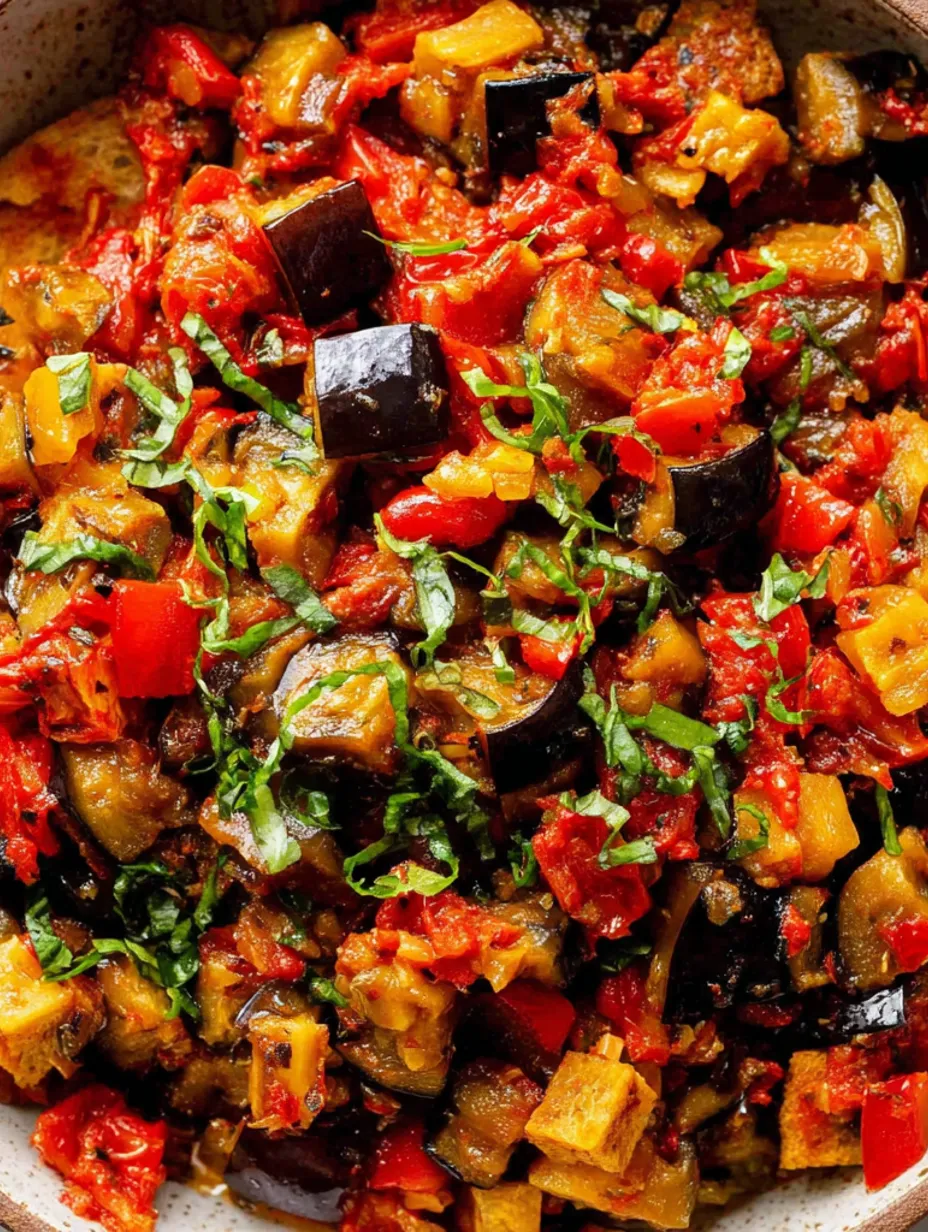 Bookmark
Bookmark
This eggplant caponata is a silky sweet and tangy Sicilian-style vegetable stew that comes alive with vibrant summer produce. It is one of my favorite ways to celebrate eggplant season and makes a perfect appetizer on crostini or a colorful addition to any mezze spread.
I first discovered caponata on a trip through southern Italy and have been hooked ever since. The version I make now has become a late summer tradition in our home.
Ingredients
- Eggplant: provides the soft velvety base and absorbs all the flavor
- Golden raisins: add natural sweetness that balances the tang
- Sherry vinegar: gives the dish its signature bright sour note
- Capers: deliver briny pops of flavor throughout
- Red bell peppers: bring color and mild sweetness
- Tomatoes: form a light sauce and deepen the overall richness
- Tomato paste: thickens the sauce and enhances the umami
- Onion and celery: add essential savory aromatics
- Garlic: boosts flavor and ties the stew together
- Extra virgin olive oil: adds richness and mouthfeel
- Fresh parsley: finishes with green brightness
- Basil: brings a fragrant final touch when garnished
- Cane sugar: gently boosts the sweetness without overpowering
Choose firm glossy eggplants and ripe juicy tomatoes for best results. Use high quality olive oil and capers packed in brine.
Step-by-Step Instructions
- Roast the Eggplant:
- Cut the eggplant into cubes and roast them until deeply golden and tender. Roasting creates a silky texture without excess oil.
- Soak the Raisins and Capers:
- Combine golden raisins sherry vinegar and capers in a small bowl. Let them sit while you prep other ingredients so they plump up with tangy flavor.
- Sauté the Aromatics:
- Heat olive oil in a large skillet. Cook onion and celery over medium heat for about eight minutes until soft and translucent which builds the base flavor.
- Add Peppers and Salt:
- Stir in the diced red bell pepper and season with salt. Cook until the peppers become soft and sweet about eight more minutes.
- Simmer the Tomato Mixture:
- Add tomato paste grated garlic chopped tomatoes and cane sugar. Cook for about eight minutes stirring often until everything breaks down into a thick sauce.
- Combine with Eggplant and Vinegar Mix:
- Add the roasted eggplant soaked raisins vinegar capers and black pepper to the skillet. Stir and cook for five minutes letting all the flavors meld.
- Finish with Herbs and Cool:
- Remove from heat and stir in the chopped parsley. Let the mixture cool to room temperature and garnish with fresh basil before serving.
 Bookmark
Bookmark
My favorite part of this dish is how the eggplant soaks up all the flavor without getting soggy. It reminds me of the first time I had it in Palermo served with chilled white wine and warm bread on a breezy terrace.
Storage Tips
Store the caponata in an airtight container in the refrigerator for up to five days. The flavor deepens with time so it is ideal for making ahead. To freeze place in a freezer safe container for up to two months and thaw in the fridge overnight.
Ingredient Substitutions
If you do not have sherry vinegar use red wine vinegar or white balsamic as alternatives. You can swap golden raisins for regular ones or finely chopped dried apricots. Green olives can be added for a more briny bite.
Serving Suggestions
Serve on toasted crostini with fresh basil or spoon onto grilled polenta. It is also excellent tossed with pasta or tucked into a sandwich with arugula and mozzarella. I love pairing it with chilled rosé on warm evenings.
 Bookmark
Bookmark
Cultural and Historical Context
Caponata comes from Sicily and reflects the island’s love for balancing sweet and sour flavors. Traditionally it was made as a way to use summer vegetables and has many regional variations some including olives pine nuts or even seafood.
Frequently Asked Questions About Recipes
- → What makes caponata different from other eggplant dishes?
Caponata is a traditional Sicilian sweet and sour vegetable stew that combines roasted eggplant with tomatoes, peppers, capers, and golden raisins. The distinctive sweet-sour balance from vinegar and sugar, plus the silky texture from properly cooked eggplant, sets it apart from other eggplant preparations.
- → Can I make caponata ahead of time?
Yes! Caponata actually improves with time and tastes best on days 2-3 after making it. The flavors meld beautifully when stored in the refrigerator for up to 5 days. Serve it chilled or bring to room temperature before serving.
- → Why roast the eggplant instead of frying it?
While traditional caponata uses fried eggplant, roasting creates a lighter version that's hands-off and less oily. Roasted eggplant still develops the silky texture and rich flavor that makes caponata so delicious, but with less oil and effort.
- → What can I serve with caponata besides crostini?
Caponata is incredibly versatile! Try it tossed with pasta, served over polenta with pine nuts, piled on toast with a poached egg, or used as a sandwich filling with arugula and mozzarella. It also works beautifully on mezze platters or cheese boards.
- → Can I substitute the golden raisins or capers?
Golden raisins add important sweetness and texture, but regular raisins work too. For capers, you could use chopped green olives, but capers provide the ideal briny flavor. The vinegar-soaking step helps both ingredients contribute their flavors more effectively to the finished dish.
- → How do I know when the vegetables are properly cooked?
All vegetables should be tender and soft - this is key to authentic caponata texture. Sauté the onion, celery, and peppers until they've completely softened, and cook the tomatoes until they break down into a saucy consistency. The eggplant should be silky and easily pierced with a fork.
